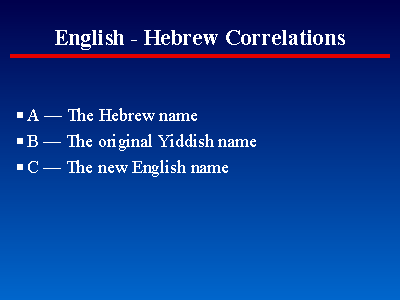 |
 |
Since Eastern European civil records reflect the secular (i.e., Yiddish) given name, that is the name that a genealogist must know in order to find official records of previous generations in Europe. For immigrants to the U.S.A., passenger arrival manifests are the best source of the Yiddish name, since they were filled out by the shipping company before immigration.
If one has no idea of a pre-Americanized name, but does know where an immigrant ancestor is buried, look at their tombstone to find the Hebrew name. Use the Hebrew name on the tombstone to form hypotheses about the possible Yiddish name, using the guidance presented here.
Each male immigrant has three different names:
Females only have two names -- the Hebrew and Yiddish names (A and B) are the same.
For genealogical purposes, we're interested in determining B, the original Yiddish name. But what we know from the tombstone is only A and C. Can you infer B from A? There's not always in a one-to-one correlation. But the correlation is much closer than that between A and C, which is often no correlation at all.